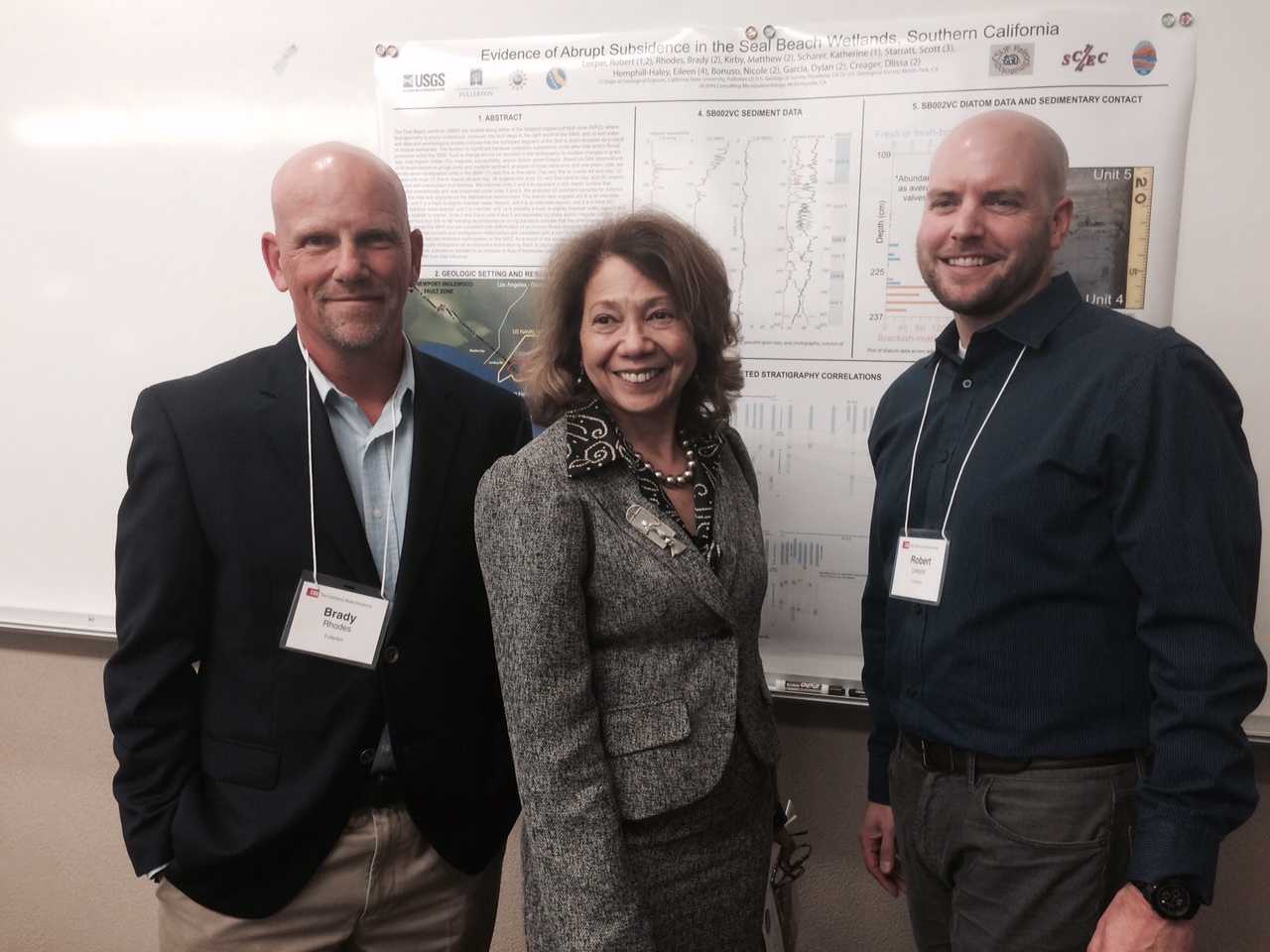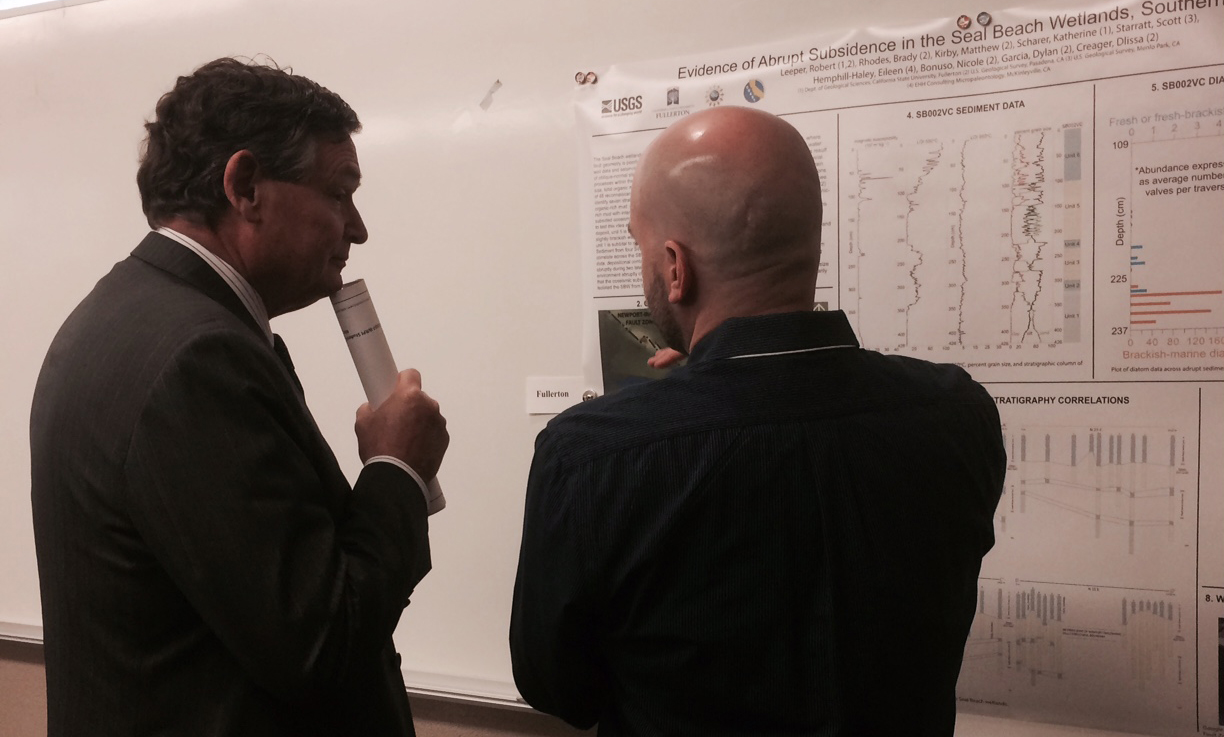Coast and WRPI research poster reception

Graduate student Robert Leeper and his advisor Dr. Brady Rhodes, presented a poster “Evidence for abrupt subsidence in the Seal Beach Wetlands, Southern California” at the student-faculty research poster reception at the C.S.U. Chancellor's Office in Long Beach on March 24, 2015. This reception was co-hosted by the C.S.U. Council on Ocean Affairs, Science and Technology (COAST) and the Water Resources and Policy Initiatives (W.R.P.I.). The poster session coincided with the C.S.U. Board of Trustees meeting, and afforded an opportunity for COAST and W.R.P.I. grant recipients (only 1 from each C.S.U. campus) to showcase their research to the trustees, C.S.U. campus presidents, and C.S.U. Chancellor. Robert’s poster drew special interest from Chancellor White who lives quite near Seal Beach and frequently kayaks along this section of coast. C.S.U.F. president Dr. Mildred Garcia also spent several minutes listening to Robert’s story.
Abstract
 The Seal Beach wetlands (S.B.W.) are located along the Newport-Inglewood fault zone (N.I.F.Z.). Coseismic subsidence along the fault should cause sudden changes in sediment of the marsh. Based on multiple analyses of sediment cores, we identify four stratigraphic units in the S.B.W.: (1) very fine to fine sand from 426-350 cm; (2) organic-rich mud from 350-225 cm; (3) fine to coarse silt and clay from 225-100 cm; and (4) organic-rich mud with interbedded mud laminae from 100-0 cm. We hypothesize that unit 2 represents a relic marsh surface that subsided coseismically. Fossil diatoms suggest unit 4 is an intertidal deposit, unit 3 is a fresh/slightly brackish water deposit, and unit 2 is an intertidal deposit. Units 2 and 3 are separated by a sharp, irregular contact. These observations are consistent with the marsh subsiding abruptly during an earthquake on the N.I.F.Z. As a result of the earthquake, the intertidal environment abruptly changed to an environment dominated by fresh to slightly brackish water. We suggest that the marsh did not flood by seawater because coseismic uplift of the southwest segment of the N.I.F.Z. temporarily isolated the S.B.W. from tidal influence. Radiocarbon dates constrain this event to <1957 cal year B.P.
The Seal Beach wetlands (S.B.W.) are located along the Newport-Inglewood fault zone (N.I.F.Z.). Coseismic subsidence along the fault should cause sudden changes in sediment of the marsh. Based on multiple analyses of sediment cores, we identify four stratigraphic units in the S.B.W.: (1) very fine to fine sand from 426-350 cm; (2) organic-rich mud from 350-225 cm; (3) fine to coarse silt and clay from 225-100 cm; and (4) organic-rich mud with interbedded mud laminae from 100-0 cm. We hypothesize that unit 2 represents a relic marsh surface that subsided coseismically. Fossil diatoms suggest unit 4 is an intertidal deposit, unit 3 is a fresh/slightly brackish water deposit, and unit 2 is an intertidal deposit. Units 2 and 3 are separated by a sharp, irregular contact. These observations are consistent with the marsh subsiding abruptly during an earthquake on the N.I.F.Z. As a result of the earthquake, the intertidal environment abruptly changed to an environment dominated by fresh to slightly brackish water. We suggest that the marsh did not flood by seawater because coseismic uplift of the southwest segment of the N.I.F.Z. temporarily isolated the S.B.W. from tidal influence. Radiocarbon dates constrain this event to <1957 cal year B.P.
